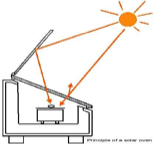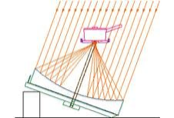
How Solar Cookers Work
Solar Cooking Works - first you need a Solar Cooker (or Solar Oven)...3 Basic principles for Solar Cooking
1. Heat Gathering
The more light / heat energy you get to your food, the quicker it will cook.
The amount of heat gathered by a solar cooker depends on the amount of surface area of the reflectors, how efficient these reflectors are and how easily that heat can get to the food.
Glass is the best material for heat transfer in a solar cooker, though not all glasses are the same. For instance the new Aussie Edition Sun Oven® uses glass that is ~20% more efficient then even it's best selling predecessor.
Plastic and double glazed glass does not transmit heat as well as single quality transparent glass. Another factor here is condensation. Many solar cookers have a virtually flat lid, meaning condensation becomes a large problem and severing limits the heat of the oven.
2. Heat Retention
The next factor effecting the speed of cooking is trapping the heat gathered (1).
There are a few ways that this can be accomplished in a solar cooker - but the only really effective way to date is in the form of an oven design.
While a panel cooker can gather heat and a parabolic cooker gathers a vast amount of heat, they can not retain mush of it. This leads to the cooker only working in direct sun and the results vary widely depending on atmospheric conditions.
An oven designed with quality insulation and a thick or double glazed lid, will retain a lot of heat during patchy clouds or even for hours after the sun goes down.
3. Heat Distribution
The distribution of the heat will affect the results of the cooked food dramatically.
Hot spots are a common problem in most types of cooking. Modern fan forced ovens overcome this partially, but as you can imagine it still remains a problem. If you think about food cooked over a fire, the bottom of the food can easily burn, while the top of the food is still frozen.
This uneven distribution of heat in a solar cooker can be a dangerous health problem. If, for instance the reflectors gather a lot of heat and concentrate the heat on one place, the part of the food (let's say a chicken) will become over cooked and tough, but there may be parts of the chicken that are uncooked and dangerous.
A large, deep, black chamber made from a material that can absorb and distribute heat (i.e. metal) is vital for even heat distribution. Ideally the reflectors would evenly heat up the oven and food inside leaving no hot spots. The Sun Oven® solar cookers demonstrate this perfectly.
Panel Cooker - Very basically the suns rays are directed at the food, either in a pot or in a bag and heat up the food slowly. Good for warming / slow heating / emergency use only.

Solar Oven - The Suns rays heat the food and the glass lid traps the heat. This creates an 'oven' effect to warm the food. Slightly hotter and more even temperature.

Parabolic Cooker - The reflectors amplify the rays of the sun many times over to create a very intense heat.

All solar cookers are not created equally! See our reviews & Tests to compare them! We have found the Global Sun Oven ® the best by far. It combines the large reflector area of a parabolic and the even heat of a solar oven.
Please consider clicking on our sponsors to keep this site active!